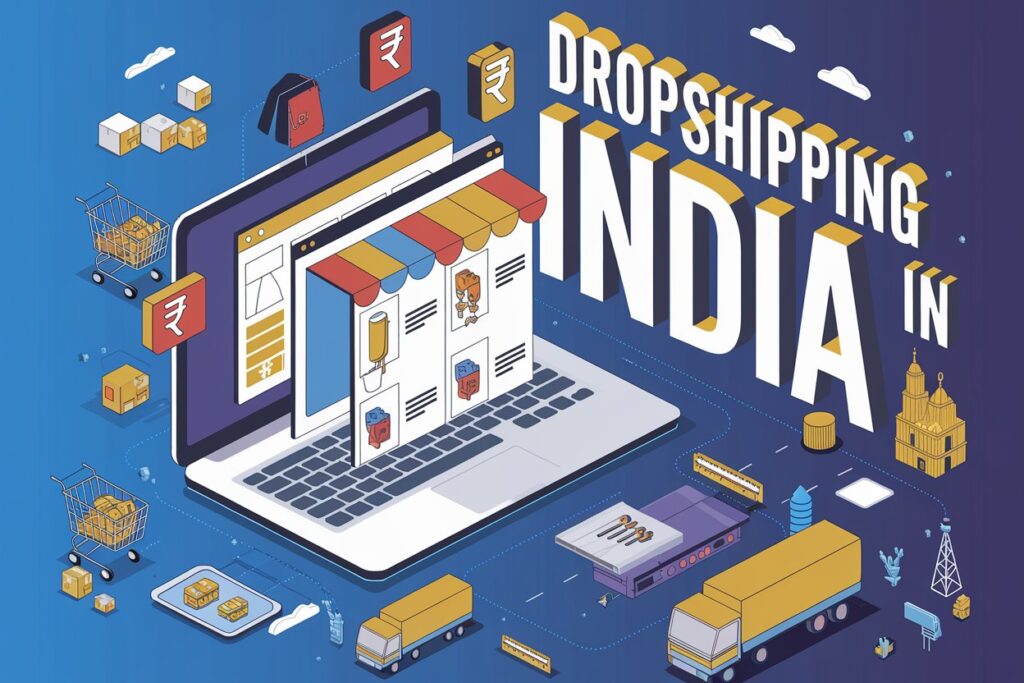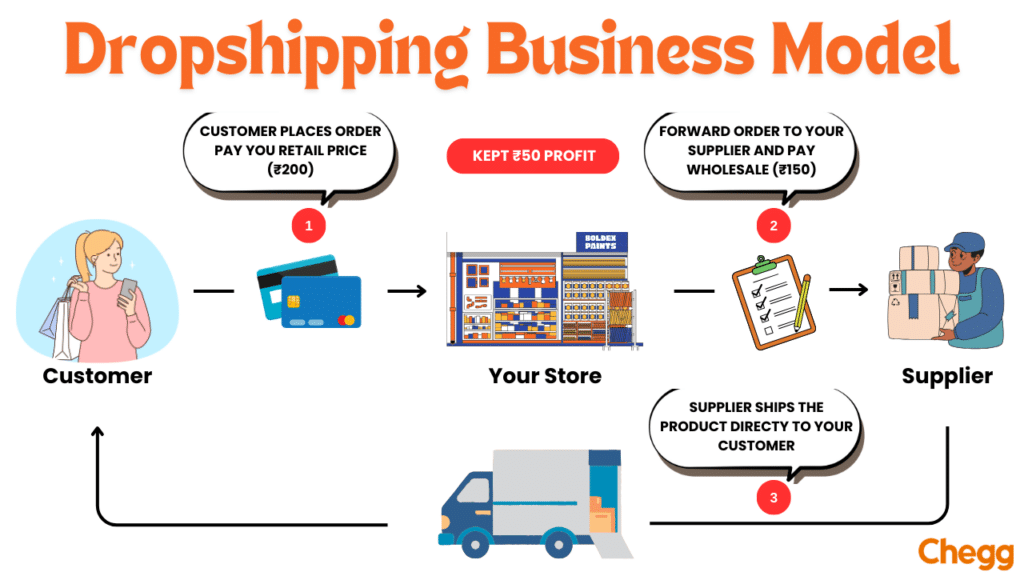

Quick Summary
In 2025, dropshipping in India will remains a lucrative online business model, allowing entrepreneurs to start with minimal investment and no inventory management. The industry presents significant opportunities with the rapid growth of e-commerce, digital payments, and internet access. This guide covers everything from understanding the dropshipping model to setting up a store, finding reliable suppliers, and scaling a successful business.

Dropshipping is a retail fulfillment method where you, as a seller, don’t keep products in stock. Instead, when a customer places an order on your online store, you purchase the product from a third-party supplier who ships it directly to the customer.
In simple terms, dropshipping in India allows you to sell products without worrying about inventory management or shipping logistics. You act as the middleman between the customer and the supplier, earning a profit margin on each sale.
Dropshipping in India is particularly appealing because of the growing e-commerce market and increasing internet penetration. It’s a great way to test different products and niches without significant financial risk.
Dropshipping is a retail fulfillment method where the seller doesn’t keep the products they sell in stock. Instead, when a customer places an order, the seller purchases the item from a third-party supplier or manufacturer, who then ships the product directly to the customer. Here’s how it typically works:

Dropshipping is popular because it requires less upfront investment and inventory management. However, it has challenges such as finding trustworthy suppliers, managing shipping delays, and handling customer service.
Starting a dropshipping business in India might seem challenging at first, but with the right approach, it’s straightforward. Here are six easy steps on how to start a dropshipping business India to help you get started:
The first step is selecting a profitable niche for your dropshipping business. A niche is a specific category of products that appeals to a particular audience. For example, fitness equipment, fashion accessories, or home decor items.
Including relevant keywords like “dropshipping in India” while researching niches can help you better understand local preferences.
Once you’ve chosen your niche, the next step is finding trustworthy suppliers. Since you won’t handle inventory yourself, partnering with reliable suppliers is crucial for success.
Communicate clearly with suppliers about shipping times, return policies, and pricing.
Your online store is where customers will browse and purchase your products. Fortunately, thanks to user-friendly platforms, setting up a store is easier than ever.
Include essential pages like Home, About Us, Contact, and FAQs when creating your store. Optimize these pages by naturally incorporating the keyword “dropshipping in India.”
Marketing is vital in driving traffic to your store and generating sales. Without effective marketing strategies, even the best products may go unnoticed.
Focus on building trust with your audience by showcasing testimonials and offering excellent customer service.
As orders come in, ensure smooth communication between your store and suppliers. Automate processes wherever possible to save time and reduce errors.
Efficient order handling is key to maintaining customer satisfaction in dropshipping in India.
Analyze your store’s performance regularly using analytics tools. Identify which products are selling well and which ones aren’t performing as expected. Use this data to refine your strategy.
Continuous improvement ensures long-term success in dropshipping in India.
Starting drop shipping in India is a low-investment business opportunity with huge potential. By following these steps—conducting market research, choosing a profitable niche, finding reliable suppliers, setting up an online store, marketing effectively, and tracking performance—you can build a successful Indian dropshipping business.

Choosing the right platform is critical for the success of your dropshipping business. Here are some of the best options available:
| Platform | Features |
|---|---|
| Shopify | Easy setup, good for beginners |
| WooCommerce | Customizable, requires WordPress |
| Amazon Dropshipping | Large customer base, higher competition |
| Flipkart Dropshipping | Trusted Indian marketplace |
Each platform caters to different needs, so choose one that aligns with your goals for dropshipping in India for beginners.
Most of these platforms integrate well with popular Indian payment gateways. Here are some options:
Choose a payment gateway that offers competitive rates and supports multiple payment methods (credit/debit cards, UPI, net banking, etc.).
When choosing a platform, consider:
Remember, the best platform for Dropshipping in India depends on your specific needs, technical expertise, and budget. Don’t hesitate to explore a few options before deciding!
Now that you know what is dropshipping. Let’s know the different types of dropshipping business in India that you can choose from.
In B2C dropshipping, businesses sell products directly to everyday customers through online stores. Think of it like an online shop where you can buy clothes, gadgets, or health products.
In this model, one business sells products to another business, often in bulk. It’s like a wholesaler supplying goods to a retail store, helping businesses stock up without holding inventory themselves.
Print-on-demand lets you create custom-designed products, like T-shirts or mugs, that are only made when someone orders them. You don’t keep stock; instead, every order is printed fresh just for the buyer.
Niche dropshipping focuses on a specific type of product or customer group, like eco-friendly items or pet supplies. This helps you stand out and attract customers who are passionate about those particular products.
Global dropshipping involves selling products from international suppliers to customers in India or other countries. This allows you to access a wide variety of products, often at lower prices.
In local dropshipping, businesses work with nearby suppliers to sell products within a specific region. This means faster shipping times and supporting local merchants and products.
Crowdfunding dropshipping uses platforms like Kickstarter to see if people want a product before you start selling. It helps you test ideas with potential customers and gather funds before production.
Subscription-based dropshipping allows customers to receive products regularly. It creates a steady income stream and helps keep customers coming back for more.

Dropshipping is a popular business model, but like any venture, it has pros and cons. Let’s break it down:
Despite these challenges, many people find that the benefits of dropshipping outweigh the drawbacks, especially when starting out in e-commerce.

Starting a dropshipping business in India is relatively low-cost compared to traditional retail businesses. Here’s a breakdown of the typical expenses you might incur:
In total, you can start a dropshipping business in India with an initial investment of around ₹10,000 to ₹30,000, depending on the scale and tools you choose. It’s a flexible and scalable business model, making it an attractive option for aspiring entrepreneurs.
Before starting your business, it’s essential to understand the legal aspects of dropshipping in India. While no specific law governs drop shipping, you must comply with general business regulations.
Adhering to these legal requirements ensures that your dropshipping business in India operates smoothly and avoids penalties.
When it comes to running a successful dropshipping business in India, choosing the right suppliers is one of the most important decisions you’ll make. A reliable supplier ensures that your customers receive high-quality products on time, which keeps them happy and boosts your reputation. Here are some top supplier platforms for dropshipping in India:
When selecting suppliers for your dropshipping business in India, always prioritize a few key factors:
By partnering with reliable suppliers like those mentioned above, you can set a strong foundation for your dropshipping business and build a loyal customer base.
Dropshipping in India offers immense opportunities for aspiring entrepreneurs. With low startup costs, flexibility, and access to global markets, starting your own online business has never been easier. You can build a thriving dropshipping venture by following the steps outlined in this guide and staying committed to learning and improving.
Remember to focus on providing value to your customers, optimizing your content for search engines, and continuously analyzing your performance. Whether you’re just starting out or scaling your existing business, dropshipping in India can transform your entrepreneurial dreams into reality.
With our Business Guide, discover Unique Business Ideas, build a successful business from scratch, and learn effective business growth strategies.
Yes, dropshipping is legal in India. However, you must comply with business registration, taxation (like GST), and consumer protection laws. Ensure you partner with reliable suppliers and avoid selling prohibited or counterfeit products.
Yes, earning ₹1 lakh per month is achievable with the right strategy. Focus on trending products, effective marketing (SEO, ads, influencers), and excellent customer service. Building a strong brand and targeting the right audience are key to scaling your business.
Manjeet Singh Sangha, also known as Desirichkid, is a successful dropshipper in India.
IndiaMART is widely considered one of the best dropshipping companies in India, as it is the largest B2B marketplace in the country, providing access to a vast network of Indian manufacturers and suppliers for dropshipping needs.
Some of the best Indian dropshipping suppliers for Shopify include vFulfill, Printrove, Syncee, and Blinkstore. These suppliers offer a wide range of products and seamless integration with Shopify.
The initial investment for dropshipping India can be as low as ₹10,000 to ₹30,000, depending on the platform, product sourcing, and marketing expenses.
Starting a dropshipping business with no money is challenging but not impossible. You can use free eCommerce platforms, promote products via social media, and rely on organic traffic to drive sales. However, investing in marketing and a domain name can significantly enhance your chances of success.
Starting with just ₹1,000 is challenging but possible. Focus on free or low-cost platforms to set up your store, like social media or free trials of e-commerce platforms. Invest in marketing wisely and choose affordable suppliers to keep costs low.

Authored by, Amay Mathur | Senior Editor




Amay Mathur is a business news reporter at Chegg.com. He previously worked for PCMag, Business Insider, The Messenger, and ZDNET as a reporter and copyeditor. His areas of coverage encompass tech, business, strategy, finance, and even space. He is a Columbia University graduate.
Editor's Recommendations
Chegg India does not ask for money to offer any opportunity with the company. We request you to be vigilant before sharing your personal and financial information with any third party. Beware of fraudulent activities claiming affiliation with our company and promising monetary rewards or benefits. Chegg India shall not be responsible for any losses resulting from such activities.
Chegg India does not ask for money to offer any opportunity with the company. We request you to be vigilant before sharing your personal and financial information with any third party. Beware of fraudulent activities claiming affiliation with our company and promising monetary rewards or benefits. Chegg India shall not be responsible for any losses resulting from such activities.